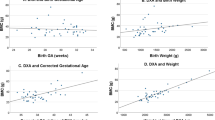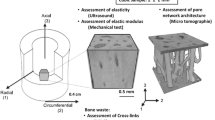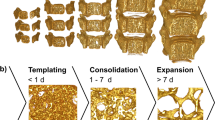Abstract
Bone quantitative ultrasound generated speed of sound (SOS) is a marker of bone strength. However, critical evaluation of its validity for use in small bones is extremely limited, and SOS data may not be consistent with data obtained from dual energy × ray absorptiometry, another marker of bone strength. We report the SOS values pre and postinjection of s.c. fat using a chicken bone model; and in large for gestation and appropriate for gestation neonates to determine the influence of s.c. fat. Average SOS were lowered for the chicken bones postfat injection by 36 m/s (CS probe) and 58 m/s (CR probe), and in large for gestation group by 75 m/s (CS probe) and 51 m/s (CR probe) (p = 0.03–0.004 paired t test) although SOS measurements from each probe are significantly correlated within the large (r = 0.78) and appropriate (r = 0.83) for gestation group. Failed SOS measurements occurred significantly more frequently in the postinjection studies regardless of the probe used in the chicken bone model and for the CS probe in large for gestation neonates. The lowered bone quantitative ultrasound measurements in large for gestation neonates is likely a measurement artifact from increased s.c. fat.
Similar content being viewed by others
Main
It is generally accepted that reduced bone mass is associated with reduced bone strength and an increase in the risk of fractures (1). Dual energy x-ray absorptiometry (DXA) is considered the gold standard for bone mass measurement, although quantitative ultrasound (QUS) of bone provides a composite measurement of material and structural properties of bone which contribute to overall bone strength (2–4). The latter is of particular interest for pediatric populations, because the instrument is generally portable, relatively easy to use, and does not require the use of ionizing radiation.
Piglet model of DXA bone mass in the range comparable to infants is predictive of bone strength (5). Large for gestational age (LGA) infants are reported to have greater absolute and proportion of DXA measured bone mass compared with appropriate for gestational age (AGA) infants (6) thus supporting there is greater bone strength. However, based on the assumption that bone strength is proportional to speed of sound (SOS) measurements, lower SOS at the tibia of LGA infants based on axial transmission QUS would support the presence of lower bone strength (7). To resolve this apparent contradictory finding, we aim to repeat the QUS study using an in vitro model to determine the effect of s.c. fat on SOS and to compare the measurements in vivo between LGA and AGA infants.
METHODS
In vitro studies.
Chicken wings and lard were obtained from commercial sources. Midpoint of the chicken wing was obtained with the use of an electronic digital caliper (Fowler caliper; WestPort Co, NY) to the nearest millimeter and marked with a water proof pen. Liquefied lard was injected s.c. extending evenly over the long axis of the radius in both directions from the mid-point mark. Various volume (0.5, 1, 1.5, 2, 3, and 5 mL) of the liquefied lard were injected. The bones were then left at room temperature for at least half hour to allow the injected lard to congeal and resolidify before repeat SOS measurement.
SOS measurements were performed in duplicate at baseline and after the injection of lard with a commercial multi-site QUS instrument (Sunlight Omnisense 7000, Sunlight Medical Ltd, Tel Aviv, Israel) using manufacturer supplied (CS and CR) probes with different dimensions of contact surface (∼2.5 × 1 cm for CS probe and 3.1 × 1.2 cm for CR probe). Both probes produce pulsed acoustic waves at a center frequency of 1.25 MHz and recommended by the manufacturer for SOS measurements of small bones in proximity to the surface of the hands and feet. These probes have been adapted for SOS measurement at the tibia and radii in infants (8–10). The center of each probe was placed over the mid point of the bone and SOS was measured as for infants (8) according to the manufacturer's recommendations.
All animal studies were performed by the same investigator (M.B.). Any unsuccessful SOS measurement was confirmed with repeating the scans by the same investigator or by another investigator (W.K.).
In vivo clinical studies.
Infants born at >37 completed weeks of gestation at Hutzel Women's Hospital were eligible for the study. All infants were products of singleton pregnancies without intrinsic or prenatal factors that might affect their skeletal status; in particular, none of the infants had neuromuscular, joint, or skeletal malformations or deformations. The infants were categorized as LGA if their birth weight was >90th percentile or AGA if their birth weight was between 11th and 90th percentile according to their gestational age (11). Gestational age estimation was determined based on a combination of the mother's last menstrual period, ultrasound dating, and physical examination. Each LGA infant was matched to an AGA infant within 1 week of completed gestation and with the same sex and race. The latter was categorized as African American or non-African American. The study protocol was approved by the Human Investigation Committee at Wayne State University and written consent was obtained from a parent of each infant.
Clinical details of the LGA and AGA neonates are shown in Table 1. For the LGA group, 51 neonates were studied with nine neonates born to mothers with abnormal glucose profile and four of these mothers required insulin therapy. SOS was measured at the left tibia with the same instrument and same probes as in vitro study. All clinical studies were performed before hospital discharge and <80 h after birth. Specific procedures for the SOS measurements were reported in detail elsewhere (8). The left mid tibia location was determined with the left knee and left ankle bend at 90 degrees using a rigid ruler and an L gauge supplied by the manufacturer. The midpoint is marked with eyeliner when two consecutive measurement of the distance between the top of the knee and the base of heel is within 2 mm. For each series of measurements, liberal amounts of coupling gel were applied to the surface of each probe in contact with the region of interest. The probe was held by the operator with both hands and its long axis aligned with the long axis of the underlying bone. The scan was performed in a sweeping fashion across the long axis of the bone with the center mark on the probe following the marked skin at all times. The final SOS in meter per second was the 95th percentile value generated by the manufacturer's software from integration of three successful measurement cycles. Any unsuccessful SOS measurement was confirmed with repeating the scans by the same investigator or by another investigator.
In our laboratory, using the manufacturer-provided System Quality Verification phantom with the expected SOS of ∼2800 m/s, the in vitro SOS acquired on each day of study >3 y showed coefficients of variation of 0.26 and 0.17% for the CS and CR probe respectively. The in vivo interoperator repeatability of SOS measurements (12) was <1% with the use of either probe (8).
Statistical analysis.
For in vitro study, the average of the two SOS measurements was used for analysis of the absolute values. In addition, the SOS measurement was considered as either successful or failed regardless of the volume of injected lard and entered into analysis as dichotomous variables. McNemar test was used to compare the number of successful SOS measurements pre- and postlard injection.
For in vivo studies, repeated measures analysis was performed on cases where successful measurements were obtained with both probes to determine the effect of probe (CS versus CR) and clinical group (LGA versus AGA) on SOS measurements and the presence of probe-clinical group interaction. McNemar tests were performed to determine differences in probe-related success or failure in SOS measurements for the LGA and AGA groups. On the basis of previous report using the same QUS technique (7), we estimated a sample size of 50 subjects would be able to detect the same extent of difference in SOS between LGA and AGA infants at an alpha of 0.05 and power of >0.8. Statistical analyses were performed with SPSS version 17.0 (SPSS Inc., Chicago, IL) at an adopted significance level of 0.05 and were two tailed.
RESULTS
In vitro studies.
Injection of s.c. lard decreased the frequency of successful SOS measurements and lowers the absolute values of SOS measurements. After an injection of 1 mL of lard, the rate of unsuccessful SOS measurements was 50% for CS probe and 16% for CR probe. The failure rate with both probes continued to increase with increasing volume of fat injected. It reached 100% for CS probe from >1.5 mL of fat; was 50% from 1.5 to 2 mL and reached 100% from >3 mL for the CR probe. Thus, the dose response studies were abandoned and all pre and post injection SOS data were combined and data are shown in Table 2.
In vivo studies.
CS and CR measured SOS were significantly correlated in LGA and AGA infants, but there were significantly fewer successful SOS measurements with the CS probe. SOS values also were significantly lower in LGA infants. Details of SOS measurements for both groups of neonates are shown in Table 3.
DISCUSSION
QUS bone measurements have universal appeal for pediatric use, because the instruments are usually portable, relative ease of use, affordability, and no radiation exposure. Commercial availability of multisite axial transmission QUS instruments theoretically would provide greater insight into the physiology and pathology of skeletal disorders, because the method provides opportunity to combine data from multiple sites. Their excellent consistency and repeatability of the SOS measurements in infants (7–9) are additional advantages. However, the commercial axial transmission instrument under investigation appears to provide consistent SOS measurement only at the tibia in small infants (7–10) and understanding of the applicability of this technique in different infant populations remain limited.
In this study, s.c. fat injection of chicken bones and LGA infants resulted in the inability to measure SOS with both CS and CR probes although it occurred less frequently with the use of CR probe. Our data do not support one probe is better than other to analyze the effect of s.c. fat on SOS measurements since the QUS system did not allow the completion of the dose response study with either probe. The correlation of SOS measurements between CS and CR probes is consistent with our previous report (8). Both this study and previous reports (8–10,13) confirmed that technical issues such as probe size and operator variability; and clinical issues such as s.c. fat or edema, gestational and postnatal age, and body weight, can provide major challenges in the application of QUS measured SOS particularly if there is relatively narrow dynamic range of SOS measurements in the clinical setting. Furthermore, SOS data from different probes and instrument are not easily interchangeable.
A major clinical implication of QUS measurements is its potential role as a marker of bone strength. In small subjects, DXA measured bone mass using a piglet model for small subjects is highly predictive of bone strength and may account for as much as 97% of the variance of bone strength (5). There is no data on the relationship between axial transmission QUS measurements and bone strength although an experimental transverse transmission QUS technique showed the sound conduction velocity at the distal radius and ulna using fetal/neonatal cadaver extremities was positively correlated to bone ash from a 2-cm section of radius and ulna. The sound conduction velocity was measured on dissected bone without surrounding soft tissue and accounted for up to 64% of the variance of the breaking strength (14). Thus, the effect of surrounding soft tissue on the predictive ability of QUS on bone strength of small bones has never been tested. Appropriate clinical interpretation of the laboratory data is important. The higher DXA measured bone mass of LGA infants (6) is therefore likely to be associated with greater bone strength and if SOS from axial transmission QUS is related to bone strength, the SOS measurements for LGA infants should be higher rather than lower than AGA infants as demonstrated in this study and by other investigators (7). Similarly, the higher SOS values in small for gestational age infants (10) compared with AGA infants also may be an artifact resulting from a lack of s.c. tissue rather than reflective of increased bone strength.
From the technical perspective, QUS velocity measurements reflect the composite of various properties of the bone such as density, architecture, and elasticity and may be affected by surrounding soft tissue (2,13). The commercial ultrasound instrument used in this study utilizes ultrasound critical angle reflectometry to measure bone SOS, thus it is possible that the output may be affected by an alteration in s.c. tissue. Our chicken bone model showed that introduction of s.c. fat result in lowered or unrecordable SOS. Our clinical data also demonstrated that QUS derived absolute SOS values and the success in obtaining SOS measurements are lowered in LGA compared with AGA infants. These data are consistent with the presence of greater amount of s.c. fat (15) and total body fat (6) in LGA infants, as well as the lower SOS measurements in LGA infants (7) and that higher birth weights may result in unrecordable SOS measurements (8,9) with the use of the same axial transmission QUS instrument. Thus, based on the principles of QUS SOS measurements, the data from our in vitro and in vivo studies indicate the lower SOS measurement in LGA infants is likely a measurement artifact.
We conclude that axial transmission QUS measurements can vary with different probe and clinical population. Lowered SOS measurement from axial transmission QUS in LGA infants is likely a technical measurement artifact from increased s.c. tissue. The clinical significance and applicability of this technique especially as a marker of bone strength remains to be determined. Commercial QUS instruments have widely different processes used for data acquisition, analysis, expression and results are not freely interchangeable (13). Successful adaptation of QUS instruments in infants and clinical applicability of any resultant measurements depend on critical studies to define the technical and clinical issues that affect interpretation of clinical data under different circumstances (13,16).
Abbreviations
- AGA:
-
appropriate birth weight for gestation
- DXA:
-
dual energy X ray absorptiometry
- LGA:
-
large for gestation
- QUS:
-
quantitative ultrasound
- SOS:
-
speed of sound
References
National osteoporosis foundation. Osteoporosis. Available at: http://www.nof.org/osteoporosis/index.htm. Accessed June 1, 2009.
Njeh CF, Hans D, Wu C, Kantorovich E, Sister M, Fuerst T, Genant HK 1999 An in vitro investigation of the dependence on sample thickness of the speed of sound along the specimen. Med Eng Phys 21: 651–659
Nicholson PH, Moilanen P, Karkkainen T, Timonen J, Cheng S 2002 Guided ultrasonic waves in long bones: modeling, experiment and in vivo application. Physiol Meas 23: 755–768
Bossy E, Talmant M, Peyrin F, Akrout L, Cloetens P, Laugier P 2004 An in vitro study of the ultrasonic axial transmission technique at the radius: 1-MHz velocity measurements are sensitive to both mineralization and intracortical porosity. J Bone Miner Res 19: 1548–1556
Koo MW, Yang KH, Begeman P, Hammami M, Koo WW 2001 Prediction of bone strength in growing animals using noninvasive bone mass measurements. Calcif Tissue Int 68: 230–234
Hammami M, Walters JC, Hockman EM, Koo WW 2001 Disproportionate alterations in body composition of large for gestational age neonates. J Pediatr 138: 817–821
Littner Y, Mandel D, Mimouni FB, Dollberg S 2004 Decreased bone ultrasound velocity in large-for-gestational-age infants. J Perinatol 24: 21–23
Koo WW, Bajaj M, Mosely M, Hammami M 2008 Quantitative bone US measurements in neonates and their mothers. Pediatr Radiol 38: 1323–1329
Liao XP, Zhang WL, He J, Sun JH, Huang P 2005 Bone measurements of infants in the first 3 months of life by quantitative ultrasound: the influence of gestational age, season, and postnatal age. Pediatr Radiol 35: 847–853
Chen M, Ashmeade T, Carver JD 2007 Bone ultrasound velocity in small- versus appropriate-for-gestational age preterm infants. J Perinatol 27: 485–489
Kuczmarski RJ, Ogden CL, Grummer-Strawn LM, Flegal KM, Guo SS, Wei R, Mei Z, Curtin LR, Roche AF, Johnson CL 2000 CDC Growth Charts: United States. Advance Data From Vital and Health Statistics; No. 314. National Center for Health Statistics, Hyattsville, MD
Gluer CC, Blake G, Lu Y, Blunt BA, Jergas M, Genant HK 1995 Accurate assessment of precision errors: how to measure the reproductibility of bone densitometry techniques. Osteoporos Int 5: 262–270
Baroncelli GI 2008 Quantitative ultrasound methods to assess bone mineral status in children: technical characteristics, performance, and clinical application. Pediatr Res 63: 220–228
Wright LL, Glade MJ, Gopal J 1987 The use of transmission ultrasonics to assess bone status in the human newborn. Pediatr Res 22: 541–544
Koo WW, Walters JC, Hockman EM 2004 Body composition in neonates: relationship between measured and derived anthropometry with dual energy X ray absorptiometry measurements. Pediatr Res 56: 694–700
Gluer CC 2007 Quantitative ultrasound—it is time to focus research efforts. Bone 40: 9–13
Author information
Authors and Affiliations
Corresponding author
Additional information
Presented at the 2008 Annual Meeting of the Pediatric Academic Societies, Honolulu, Hawaii.
Rights and permissions
About this article
Cite this article
Bajaj, M., Koo, W., Hammami, M. et al. Effect of Subcutaneous Fat on Quantitative Bone Ultrasound in Chicken and Neonates. Pediatr Res 68, 81–83 (2010). https://doi.org/10.1203/PDR.0b013e3181df9c8c
Received:
Accepted:
Issue Date:
DOI: https://doi.org/10.1203/PDR.0b013e3181df9c8c
This article is cited by
-
Is quantitative ultrasound a measure for metabolic bone disease in preterm-born infants? A prospective subcohort study
European Journal of Pediatrics (2021)



